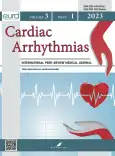Long QT Syndrome in Young Athletes
- Authors: Chuprova S.N.1,2, Melnikova I.Y.1
-
Affiliations:
- North-Western State Medical University named after I.I. Mechnikov
- Federal State-Financed Institution Pediatric Research and Clinical Center for Infectious Diseases under the Federal Medical Biological Agency
- Issue: Vol 3, No 1 (2023)
- Pages: 41-48
- Section: Case reports
- URL: https://journals.rcsi.science/cardar/article/view/132567
- DOI: https://doi.org/10.17816/cardar321415
- ID: 132567
Cite item
Abstract
Long QT syndrome is a disease associated with a high risk of sudden cardiac (arrhythmic) death. The frequency of sudden cardiac death is approximately 1: 100,000 young athletes, while autopsies often do not detect changes, which indicates a primary arrhythmogenic death. The article describes two clinical cases of young athletes with prolongation of the QT interval. The possible causes of the long QT syndrome and the difficulties of diagnosing this syndrome in children and adolescents involved in sports are discussed. Regardless of the reasons leading to the prolongation of the QT interval, there is a risk of arrhythmic events. Timely diagnosis of long QT syndrome is the way to the primary prevention of sudden cardiac death in young athletes.
Full Text
##article.viewOnOriginalSite##About the authors
Svetlana N. Chuprova
North-Western State Medical University named after I.I. Mechnikov; Federal State-Financed Institution Pediatric Research and Clinical Center for Infectious Diseases under the Federal Medical Biological Agency
Author for correspondence.
Email: svetlana_ch_70@mail.ru
ORCID iD: 0000-0002-5661-3389
SPIN-code: 8696-7178
Associate Professor
Russian Federation, Saint Petersburg; Saint PetersburgIrina Yu. Melnikova
North-Western State Medical University named after I.I. Mechnikov
Email: melnikovai@yandex.ru
ORCID iD: 0000-0002-1284-5890
SPIN-code: 8053-1512
Head of the Department
Russian Federation, Saint PetersburgReferences
- Makarov LM. Sport and sudden death in children. Russian Bulletin of Perinatology and Pediatrics. 2017;62(1):40–46. (In Russ.) doi: 10.21508/1027-4065-2017-62-1-40-46
- Longo UG, Ambrogioni LR, Ciuffreda M, et al. Sudden cardiac death in young athletes with long QT syndrome: the role of genetic testing and cardiovascular screening. Br Med Bull. 2018;1(127): 43–53. doi: 10.1093/bmb/ldy017
- Krahn AD, Laksman Z, Sy RW, et al. Congenital Long QT syndrome. JACC Clin Electrophysiol. 2022;8(5):687–706. doi: 10.1016/j.jacep.2022.02.017
- Schwartz PJ. Idiopathic long QT syndrome: progress and questions. Am Heart J. 1985;109(2):399–411. doi: 10.1016/0002-8703(85)90626-x
- Sy RW, van der Werf C, Chattha IS, et al. Derivation and validation of a simple exercise-based algorithm for prediction of genetic testing in relatives of LQTS probands. Circulation. 2011;124(20):2187–2194. doi: 10.1161/CIRCULATIONAHA.111.028258
- Schwartz PJ, Crotti L. QTc behavior during exercise and genetic testing for the long-QT syndrome. Circulation. 2011;124(20): 2181–2184. doi: 10.1161/CIRCULATIONAHA.111.062182
- Adler A, Novelli V, Amin AS, et al. An International, Multicentered, Evidence-Based Reappraisal of Genes Reported to Cause Congenital Long QT Syndrome. Circulation. 2020;141(6):418–428. doi: 10.1161/CIRCULATIONAHA.119.043132
- Arthur AM, Ahmad S, Pieter G Diagnosis, management and therapeutic strategies for congenital long QT syndrome. Heart. 2021;108(5):332–338. doi: 10.1136/heartjnl-2020-318259
- Makarov LM, Komolyatova VN, Kupriyanova OO, et al. National russian guidelines on application of the methods of holter monitoring in clinical practice. Russian Journal of Cardiology. 2014;2(106):6–71. (In Russ.). doi: 10.15829/1560-4071-2014-2-6-71
- Tardo DT, Peck M, Subbiah RN, et al. The diagnostic role of T wave morphology biomarkers in congenital and acquired long QT syndrome: A systematic review. Ann Noninvasive Electrocardiol. 2022. 28(1):e13015. DOI: doi: 10.1111/anec.13015
- Singh M, Morin DP, Link MS. Sudden cardiac death in Long QT syndrome (LQTS), Brugada syndrome, and catecholaminergic polymorphic ventricular tachycardia (CPVT). Prog Cardiovasc Dis. 2019; 62(3):227–234. doi: 10.1016/j.pcad.2019.05.006
- Pelliccia A, Adami PE, Quattrini F, et al. Are Olympic athletes free from cardiovascular diseases? Systematic investigation in 2352 participants from Athens 2004 to Sochi 2014. Br J Sports Med. 2017;51(4):238–243. doi: 10.1136/bjsports-2016-096961
- Schnell F, Behar N, Carré F. Long-QT Syndrome and Competitive Sports. Arrhythm Electrophysiol Rev. 2018;7(3):187–192. doi: 10.15420/aer.2018.39.3
- Pelliccia A, Fagard R, Bjørnstad HH, et al. Recommendations for competitive sports participation in athletes with cardiovascular disease: a consensus document from the Study Group of Sports Cardiology of the Working Group of Cardiac Rehabilitation and Exercise Physiology and the Working Group of Myocardial and Pericardial Diseases of the European Society of Cardiology // Eur Heart J. 2005;14(26):1422–1445. doi: 10.1093/eurheartj/ehi325
- Priori S.G., Blomström-Lundqvist C., Mazzanti A., et al. 2015 ESC Guidelines for the management of patients with ventricular arrhythmias and the prevention of sudden cardiac death: The Task Force for the Management of Patients with Ventricular Arrhythmias and the Prevention of Sudden Cardiac Death of the European Society of Cardiology (ESC). Endorsed by: Association for European Paediatric and Congenital Cardiology (AEPC) // Eur Heart J. 2015;(36):2793–867. doi: 10.1093/eurheartj/ehv316
- Ackerman MJ, Zipes DP, Kovacs RJ, et al. Eligibility and disqualification recommendations for competitive athletes with cardiovascular abnormalities: Task Force 10: The Cardiac Channelopathies: A Scientific Statement From the American Heart Association and American College of Cardiology. J Am Coll Cardiol. 2015;66(21):2424–2428. doi: 10.1016/j.jacc.2015.09.042
- Boitsov SA, Kolos IP, Lidov PI, et al. Natsional'nye rekomendatsii po dopusku sportsmenov s otkloneniyami so storony serdechno-sosudistoi sistemy k trenirovochno-sorevnovatel'nomu protsessu. Rational Pharmacotherapy in Cardiology. 2011;7(6):4–60. (In Russ.).
Supplementary files
















